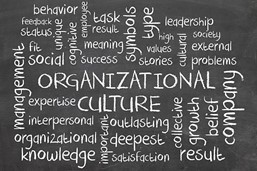Content begins here
Contenido de la página principal
Pulsa para colapsar
Leadership styles - Organisational culture
Introduction
The organisational culture or corporate culture refers to the shared values, standards, attitudes, beliefs, and behaviours that contribute to the unique social and psychological environment of an organisation, being a studying/working group, association, or company, small or big.

Organisational culture includes written (formal, e.g. statutes that have to be written by law in companies or associations) and unwritten (informal, e.g. experience, beliefs) rules that have been developed over time and are considered valid by the organisation members. This culture is expressed in the organisation goals, strategy and structure, as well as in its philosophy, self-image, and interaction with the outside world (providers, customers, society...)
Once this lesson is completed and approved, learners will be able to:
1. Distinguish different styles of organisational cultures.
2. Choose and apply organisational cultures.
In this lesson, we will get an overview of the main cultural elements that can rule formally or informally a team, and we will learn that we can intentionally work on those cultural elements.
Types of Organisational Culture
Here are some of the main types of culture that can be found in an organisation:
- Power Culture
In an organisation with a power culture, power is held by just a few individuals whose influence spreads throughout the organisation. This is the case, for instance, of family businesses.
- Role Culture
Organisations with a role culture are based on rules. They are highly controlled, with everyone in the organisation knowing what their roles and responsibilities are. Power in a role culture is determined by a person's position (role) in the organisational structure.
- Task Culture
Task culture forms when teams in an organisation are formed to address specific problems or progress projects. The task is the important thing, so power within the team will often shift depending on the mix of the team members and the status of the problem or project.
- Person Culture
In organisations with personal cultures, individuals very much see themselves as unique and superior to the organisation.
- Adhocracy Culture
This culture is based on energy and creativity. Employees are encouraged to take risks, and leaders are seen as innovators or entrepreneurs. The organisation is held together by experimentation, with an emphasis on individual ingenuity and freedom.
- Market Culture
This culture is built upon the dynamics of competition and achieving concrete results. The focus is goal-oriented, with leaders who are tough and demanding.
To choose and create an organizational culture
The types of organisational culture described above are not exhaustive and can be mixed up and changed until each organisation creates its own and unique culture. This mix will depend on the focus of the organisation / working group / company on internal structure and integration vs. external focus and differentiation, stability and control vs. flexibility and discretion, etc. Given every project or company is different, there are many ways to develop a culture that works.
At the beginning of a project, entrepreneurs naturally tend to take on a great deal of responsibility themselves. As the project grows and gets more formal, that you start hiring employees etc., this authoritarian management style used at the beginning can become a problem. In a healthy culture, the working team has to be aware of being part of a team and gain satisfaction from helping to the overall organisation success. When the team senses that it is contributing to a successful group effort, its level of commitment and productivity, and thus the quality of the company's products or services, are likely to improve.
Conclusion
Any working group is ruled by a culture, formal or informal, intentional, or not. What is important is to become aware of this organisational culture so one discovers that it is not a set feature, but something that can be intentionally changed and improved for optimum teamwork.
Video and PDF presentationPulsa para colapsar
The following video explains the content of this lesson and shows some examples:
Video T7.L1. Leadership styles - Organizational culture
Here you have the content of the video in pdf in case you need to use it in your classroom:
Lesson contents in PDFPulsa para colapsar
Here you have the contents of the lesson in PDF:

